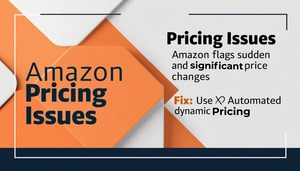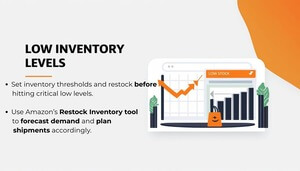Understanding Amazon Quality Alerts
Amazon stocks more than 12 million products, and to keep it a reputable marketplace, Amazon follows stringent quality control measures. One such measure is the Amazon Quality Alert that notifies sellers whether their product listings are not meeting the quality standards of Amazon. The alerts guarantee that every product listing features accurate descriptions, high-quality images, and competitive prices, eventually rendering the finest shopping experience to customers.
If you’ve been sent a quality alert, don’t panic. While they sound threatening, quality alerts are really instructions on how to improve your listings and keep your store compliant. Understanding why you received a quality alert and how to correct it helps you remain compliant and get the most product exposure on Amazon’s marketplace.
What is an Amazon Seller Quality Alert?
An alert for quality is a notice that Amazon sends, which notifies your product listings do not live up to certain expectations. Such alerts may be caused by the absence of product details, inappropriate categorization, inconsistency in pricing, or even low-quality product images. Amazon issues these notifications to sellers, signaling the required improvements to listing quality and staying within platform policy requirements.
Resolving these notifications is quite easy. Sellers can go to their product listing page, where Amazon offers a summary of the notification and step-by-step directions on how to resolve it. By correcting the necessary adjustments in a timely manner, sellers can improve their listings and prevent possible account suspensions.
Why Quality Alerts Are Important
Just as a physical storefront must have a neat, tidy storefront to attract customers, sellers on Amazon must have well-optimized product listings. A suboptimal listing can deter buyers and damage conversion rates. Quality alerts are a preventive tool that enables sellers to maintain high standards, and this leads to better search rankings, increased customer trust, and ultimately more sales.
Besides, customer experience is Amazon’s priority, and quality alerts guarantee sellers adhere to this goal. If your listing does not meet Amazon standards, it may not rank high in search results or, under the worst possible scenario, be suppressed entirely. By addressing quality alerts as soon as possible, you increase your product’s visibility and outmaneuver the competition.
Common Reasons for Amazon Quality Alerts
Being aware of the causes of Amazon quality alerts in advance enables sellers to steer clear of them and enjoy a good reputation on the platform. Some of the most prevalent causes and how to rectify them are detailed below:
1. Pricing Discrepancies

Amazon focuses on competitive and stable pricing. A quality alert can occur when a product’s price varies significantly from competition or from its historical prices. Such an issue frequently occurs when prices are entered manually by the sellers without keeping up with Amazon’s dynamic pricing process.
To minimize this risk, you must employ Amazon’s automated pricing tools. These alter prices automatically in real-time based on market trends, competition price, and demand from buyers. Using this technology, you will be able to maintain your listings competitively priced, stable, and within Amazon’s specifications, minimizing the possibility of an alert.
2.Low Listing Quality Index (LQI)

Amazon gives every product listing a Listing Quality Index (LQI) score that measures its general performance. It takes into account several factors such as product description, images, shipping, and customer reviews. A low LQI rating—usually lower than 60—may induce a quality alert, which can prompt sellers to improve their listing to Amazon standards.
To enhance your LQI score, concentrate on writing rich and concise product descriptions using relevant keywords to enhance visibility. Quality professional photographs, clean and distinctive bullets, and an optimized product title are equally essential in enhancing the attractiveness and performance of your listing. Equally, be sure that shipping features fit the expectations of customers to prevent feedback that can lower your score.
3.Low Inventory Levels

When you make use of Amazon’s Fulfillment by Amazon (FBA) service, having low inventories can trigger a quality alert. Amazon appreciates products whose inventory levels consistently remain high, and if yours fall too low, it is likely to influence your sales rank and Buy Box eligibility.
In order to avoid this, put in place an inventory system that monitors stocks and has reorder levels. Keep checking the trends of sales and predict seasonal demand to make sure that products are in stock.
4.Negative Customer Reviews and Ratings

Customer reviews are important to the success of an Amazon seller. When a product has a large number of negative reviews, Amazon will send a quality alert. Repeated complaints regarding product defects, deceptive descriptions, or bad customer service can signal a problem that requires prompt attention.
To counteract this, interact with customers by replying to complaints and providing solutions. Ask happy customers to post positive reviews to offset your overall score. Furthermore, enhance product descriptions so that they describe the product accurately being sold.
5.Misleading Titles and Descriptions

Amazon’s algorithm employs product titles and descriptions to compare search queries. If your listing has misleading, incomplete, or keyword-stuffed data, it can cause a quality alert. Titles that exceed the character limit or descriptions with excessively promotional content can also be detected.
To correct this, comply with Amazon’s listing guidelines. Employ concise, descriptive titles and ensure descriptions adequately elicit major features and benefits. Avoid unnatural keyword stuffing and emphasize readability.
6.Image Quality Issues

Images need to be top-notch in affecting conversions and conforming to Amazon requirements. The site asks sellers to submit distinct, professional images showing various angles of a product. Blurry, watermarked, or non-conforming images can result in a quality alert, damaging your listing visibility and sales.
To make your images Amazon-compliant and attract more buyers:
- Use high-definition images with a resolution of 1000 pixels or more on the longest side so clear images and Amazon zoom can be utilized.
- Show the main image over a white background (RGB 255, 255, 255) to comply with Amazon’s stringent policies and maintain a clean and professional look.
- Remove watermarks, text overlays, or any other distracting features that draw attention away from the product and violate Amazon’s policies.
How to Resolve Amazon Quality Alerts
If you get a quality alert, do the following to correct the problem:
1.Log in to Amazon Seller Central and go to the “Manage Inventory” page.
2. Find the alert icon, typically in the form of an exclamation mark beside the involved product listing.
3. Mouse over the icon to see information regarding the alert.
4. Press “Edit” on the involved product listing and correct the necessary changes.
5. Save and resubmit the updates for Amazon review.
Amazon will process the updates in 24-48 hours. If the problem still persists, reach out to Amazon Seller Support for further help.
Best Practices to Avoid Amazon Quality Alerts
To minimize the risk of quality alerts, sellers have to be proactive. Here’s how to remain compliant and maximize performance:
Stay on Top of Amazon’s Policies:
Learn about Amazon’s seller and listing policies—and stay current on updates—to be fully compliant and avoid inadvertent infringement.
Regularly Audit Your Listings:
Periodically check product descriptions, price, and image to identify and fix problems such as inaccuracies or inconsistencies ahead of time, before they launch alerts.
Maintain Listings on a Continuous Basis:
Optimize product titles, descriptions, and images to make them current according to market developments and consumer wishes, increasing relevance and attractiveness.
Monitor Inventory Regularly:
Run an inventory tracking system to update stock levels constantly, avoiding stockouts that will result in problems with quality or performance.
Take Customer Engagement to the Foremost Position:
Answer customers’ questions and complaints in a timely manner, solve issues promptly, and inspire good reviews to uphold a robust reputation.
How AI Can Help Amazon Sellers Manage Quality Alerts Improving
Artificial Intelligence (AI) is transforming the way Amazon sellers do business. AI tools are capable of optimizing and automating selling operations, reducing the likelihood of quality alerts and improving overall efficiency.
AI-Powered Listing Optimization:
AI-based tools can review product listings and suggest improvement based on Amazon’s ranking algorithm. Sellers can elevate their LQI scores and stay away from quality alerts by using AI analysis to optimize titles, descriptions, and pictures.
Automated Price Adjustments:
AI-based repricing tools constantly monitor competitor prices and adjust prices in real-time. This enables sellers to remain competitive without making sudden price adjustments that will trigger an alert.
Predictive Inventory Management:
Artificial intelligence is capable of predicting the patterns of demand, and so sellers will possess the ideal stock levels. This reduces the possibilities of overstocking or stockouts with an efficient supply chain.
Sentiment Analysis for Reviews:
Sentiment analysis tool that is driven by AI is able to scrutinize customer reviews to identify repetitive complains and the issues that need fixing. Sellers will be able to fix these before they hit their ratings.
Through the use of the strengths of AI, Amazon sellers can enhance operational efficiency, enhance listing quality, and reduce quality notifications by a considerable percentage. Through the use of AI-driven solutions, sellers can remain competitive while offering a world-class shopping experience to customers.
Conclusion:
Amazon Quality Alerts should not be punitive but instead help sellers keep high-quality listings and ensure customer satisfaction. Sellers can prevent disruptions and unlock their potential sales by being aware of root causes and doing their best practices. Being proactive and compliant helps have a hassle-free selling experience and assists in building a successful and reputable Amazon business.

